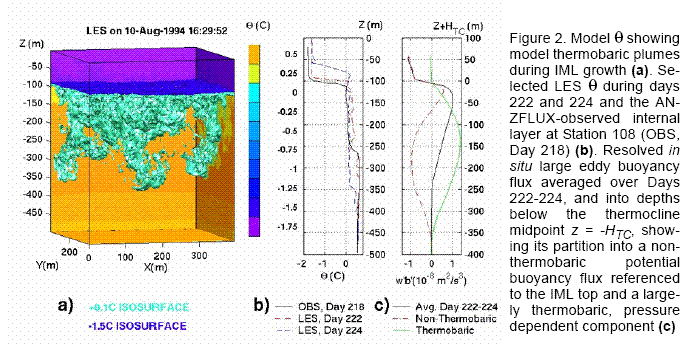
 |
A modelling effort has been undertaken to study Weddell Sea thermohaline structure and forcing, using a Large Eddy Simulation (LES) numerical model (Moeng 1984; Harcourt et al. 2002). The model was initialized to the least thermobarically stable profile discussed by McPhee (2000), and forced with surface stress and conductive heat flux in the ice cover inferred from buoy measurements some distance away.
The figure above (Harcourt, in preparation) summarizes some model results from this current effort. The LES reveals a complex instability that combines cabbeling instability at the bottom of the pycnocline with thermobaric convection below the SML. Following three simulated days of ice formation over a 100 m thick SML, a distinct and decoupled Internal Mixed Layer (IML) with O(1cm s-1) rms velocity scales forms below the thermocline, entraining upwards 30 m into the SML and downwards more than 300 m. Initially, mixing within the lower thermocline produces a mean density inversion due to cabbeling between SML fluid and warm, salty deep water.
The vertical flux of buoyant parcels out of this density inversion produces enough Turbulent Kinetic Energy (TKE) to create a relatively homogeneous layer delimited above and below by the neutral buoyancy depths of these parcels. As this layer grows, this neutral depth for relatively cold parcels (Fig. 2a) accelerated downward from the cabbeling instability is increasingly magnified by thermobaricity, and within hours TKE production within the IML becomes dominated by the thermobaric component of buoyancy flux (Fig. 2c). The LES modeled IML bears a striking resemblance (Fig. 2b) to profiles observed near this location during ANZFLUX. Like Type II thermobaric mixing, this combination cabbeling and thermobaricity also raises heat towards the surface without as much surface warming and associated ice melt as SML deepening through entrainment. This instability might be called thermobaric cabbeling or Type III thermobaricity to distinguish it from others. Further analysis shows that conditions for the same instability can also be approached either by vertically stretching the water column or through differential advection of the SML over deep water, in addition to the approach modeled here where SML density first increases due to surface ice formation.
Because of the thermal barrier effect, Type II instability is most effective when the greatest temperature contrast occurs over the shortest vertical distance, i.e., well defined steps with the large T/S differences, but vanishing difference in density at the pressure surface separating the two layers (McPhee 2000). It appears that the Type III process could play a key role in preconditioning a particular region for convection strong enough to destroy the ice cover. Several other mechanisms may also contribute to mixing in the interior of the water column, among them (i) double diffusive convection (“DDC”) (Muench et al., 1990); (ii) internal wave breaking (e.g., Gregg, 1987); and (iii) differential advection of a horizontal density gradient in a shear flow (Crawford et al. 1999). However, for removing the ice cover by purely vertical processes, the prime test of any combination of factors is whether the mixing of heat upward can be sustained long enough to overcome the strongly stabilizing influence of ice melt, i.e., the thermal barrier. By a simple thought experiment involving the deepening of the interface between two layers starting at neutral thermobaric stability, McPhee (2003) showed that the rate of heat transfer at the ice/ocean boundary is another critical factor in the competition between buoyancy added by melting, and that subtracted by conversion of potential energy of the water column.
Following the field season, LES modeling will contribute to the evaluation of observations by simulating ensembles of virtual observations in turbulence-resolving simulations of NES instabilities based on observations.
Study participantes: Ramsey Harcourt